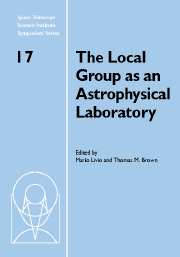 The Local Group as an Astrophysical Laboratory
The Local Group as an Astrophysical Laboratory Book contents
- Frontmatter
- Contents
- Participants
- Preface
- History of the Local Group
- Primordial nucleosynthesis
- Galactic structure
- The Large Magellanic Cloud: Structure and kinematics
- The Local Group as an astrophysical laboratory for massive star feedback
- Hot gas in the Local Group and low-redshift intergalactic medium
- Stages of satellite accretion
- The star formation history in the Andromeda halo
- Bulge populations in the Local Group
- The Local Group as a laboratory for the chemical evolution of galaxies
- Massive stars in the Local Group: Star formation and stellar evolution
- Massive Young Clusters in the Local Group
- Magellanic Cloud planetary nebulae as probes of stellar evolution and populations
- The old globular clusters: Or, life among the ruins
- Chemical evolution models of Local Group galaxies
History of the Local Group
Published online by Cambridge University Press: 12 May 2010
- Frontmatter
- Contents
- Participants
- Preface
- History of the Local Group
- Primordial nucleosynthesis
- Galactic structure
- The Large Magellanic Cloud: Structure and kinematics
- The Local Group as an astrophysical laboratory for massive star feedback
- Hot gas in the Local Group and low-redshift intergalactic medium
- Stages of satellite accretion
- The star formation history in the Andromeda halo
- Bulge populations in the Local Group
- The Local Group as a laboratory for the chemical evolution of galaxies
- Massive stars in the Local Group: Star formation and stellar evolution
- Massive Young Clusters in the Local Group
- Magellanic Cloud planetary nebulae as probes of stellar evolution and populations
- The old globular clusters: Or, life among the ruins
- Chemical evolution models of Local Group galaxies
Summary
It is suggested that M31 was created by the early merger and subsequent violent relaxation of two or more massive metal-rich ancestral galaxies within the core of the Andromeda subgroup of the Local Group. On the other hand, the evolution of the main body of the Galaxy appears to have been dominated by the collapse of a single ancestral object that subsequently evolved by capturing a halo of small metal-poor companions. It remains a mystery why the globular cluster systems surrounding galaxies like M33 and the LMC exhibit such striking differences in evolutionary history. It is argued that the first generation of globular clusters might have been formed nearly simultaneously in all environments by the strong pressure increase that accompanied cosmic reionization. Subsequent generations of globulars may have formed during starbursts that were triggered by collisions and mergers of gas-rich galaxies.
The fact that the [G]alactic system is a member of a group is a very fortunate accident. Hubble (1936, p. 125)
Introduction
According to Greek mythology, the goddess of wisdom, Pallas Athena, clad in full armor, emerged from Zeus's head after Hephaestus split it open. In much the same way the Local Group sprang forth suddenly, and almost complete, in Chapter VI of The Realm of the Nebulae (Hubble 1936, pp. 124–151). Hubble describes the Local Group as “a typical small group of nebulae which is isolated in the general field.” He assigned (in order of decreasing luminosity) M31, the Galaxy, M33, the Large Magellanic Cloud, the Small Magellanic Cloud, M32, NGC 205, NGC 6822, NGC 185, IC 1613 and NGC 147 to the Local Group, and regarded IC 10 as a possible member.
- Type
- Chapter
- Information
- The Local Group as an Astrophysical LaboratoryProceedings of the Space Telescope Science Institute Symposium, held in Baltimore, Maryland May 5–8, 2003, pp. 1 - 15Publisher: Cambridge University PressPrint publication year: 2006
- 7
- Cited by


